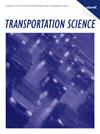Multimodal Vaccine Distribution Network Design with Drones
IF 4.8
2区 工程技术
Q1 OPERATIONS RESEARCH & MANAGEMENT SCIENCE
引用次数: 3
Abstract
Childhood vaccines play a vital role in social welfare, but in hard-to-reach regions, poor transportation, and a weak cold chain limit vaccine availability. This opens the door for the use of vaccine delivery by drones (uncrewed aerial vehicles, or UAVs) with their fast transportation and reliance on little or no infrastructure. In this paper, we study the problem of strategic multimodal vaccine distribution, which simultaneously determines the locations of local distribution centers, drone bases, and drone relay stations, while obeying the cold chain time limit and drone range. Two mathematical optimization models with complementary strengths are developed. The first model considers the vaccine travel time at the aggregate level with a compact formulation, but it can be too conservative in meeting the cold chain time limit. The second model is based on the layered network framework to track the vaccine flow and travel time associated with each origin-destination (OD) pair. It allows the number of transshipments and the number of drone stops in a vaccine flow path to be limited, which reflects practical operations and can be computationally advantageous. Both models are applied for vaccine distribution network design with two types of drones in Vanuatu as a case study. Solutions with drones using our parameter settings are shown to generate large savings, with differentiated roles for large and small drones. To generalize the empirical findings and examine the performance of our models, we conduct comprehensive computational experiments to assess the sensitivity of optimal solutions and performance metrics to key problem parameters. History: This paper has been accepted for the Transportation Science Special Issue on Emerging Topics in Transportation Science and Logistics. Funding: This work was supported by the Association for Supply Chain Management (ASCM) and the University of Missouri Research Board (UMSL Award 0059109). Supplemental Material: The online supplement is available at https://doi.org/10.1287/trsc.2023.1205 .无人机多模式疫苗配送网络设计
儿童疫苗在社会福利中发挥着至关重要的作用,但在难以到达的地区,交通不便和冷链薄弱限制了疫苗的供应。这为无人机(无人机)提供疫苗打开了大门,无人机的运输速度快,几乎不依赖或根本不依赖基础设施。在本文中,我们研究了战略多模式疫苗分发问题,该问题同时确定了当地分发中心、无人机基地和无人机中继站的位置,同时遵守冷链时间限制和无人机范围。建立了两个具有互补优势的数学优化模型。第一个模型以紧凑的配方在总体水平上考虑了疫苗的旅行时间,但在满足冷链时间限制方面可能过于保守。第二个模型基于分层网络框架来跟踪与每个出发地-目的地(OD)对相关的疫苗流和旅行时间。它允许限制疫苗流动路径中的转运次数和无人机停留次数,这反映了实际操作,在计算上可能是有利的。这两种模型都应用于瓦努阿图两种无人机的疫苗分发网络设计,作为案例研究。使用我们的参数设置的无人机解决方案可以节省大量费用,大型和小型无人机的作用不同。为了推广经验发现并检验我们模型的性能,我们进行了全面的计算实验,以评估最优解和性能指标对关键问题参数的敏感性。历史:本文已被运输科学特刊《运输科学与物流新兴主题》接受。资金:这项工作得到了供应链管理协会(ASCM)和密苏里大学研究委员会的支持(UMSL奖0059109)。补充材料:在线补充可在https://doi.org/10.1287/trsc.2023.1205。
本文章由计算机程序翻译,如有差异,请以英文原文为准。
求助全文
约1分钟内获得全文
求助全文
来源期刊

Transportation Science
工程技术-运筹学与管理科学
CiteScore
8.30
自引率
10.90%
发文量
111
审稿时长
12 months
期刊介绍:
Transportation Science, published quarterly by INFORMS, is the flagship journal of the Transportation Science and Logistics Society of INFORMS. As the foremost scientific journal in the cross-disciplinary operational research field of transportation analysis, Transportation Science publishes high-quality original contributions and surveys on phenomena associated with all modes of transportation, present and prospective, including mainly all levels of planning, design, economic, operational, and social aspects. Transportation Science focuses primarily on fundamental theories, coupled with observational and experimental studies of transportation and logistics phenomena and processes, mathematical models, advanced methodologies and novel applications in transportation and logistics systems analysis, planning and design. The journal covers a broad range of topics that include vehicular and human traffic flow theories, models and their application to traffic operations and management, strategic, tactical, and operational planning of transportation and logistics systems; performance analysis methods and system design and optimization; theories and analysis methods for network and spatial activity interaction, equilibrium and dynamics; economics of transportation system supply and evaluation; methodologies for analysis of transportation user behavior and the demand for transportation and logistics services.
Transportation Science is international in scope, with editors from nations around the globe. The editorial board reflects the diverse interdisciplinary interests of the transportation science and logistics community, with members that hold primary affiliations in engineering (civil, industrial, and aeronautical), physics, economics, applied mathematics, and business.
 求助内容:
求助内容: 应助结果提醒方式:
应助结果提醒方式:


